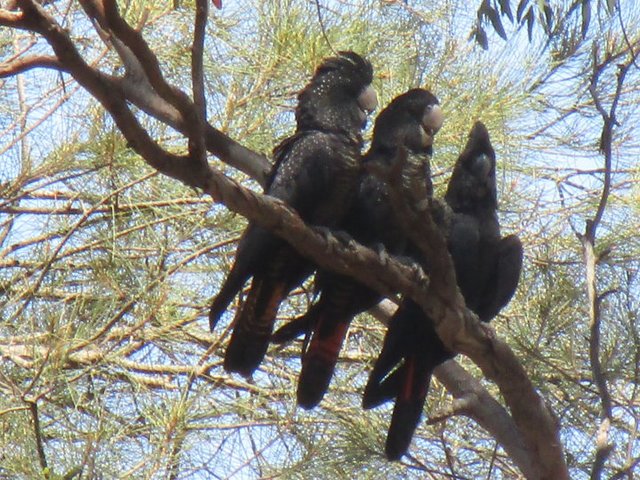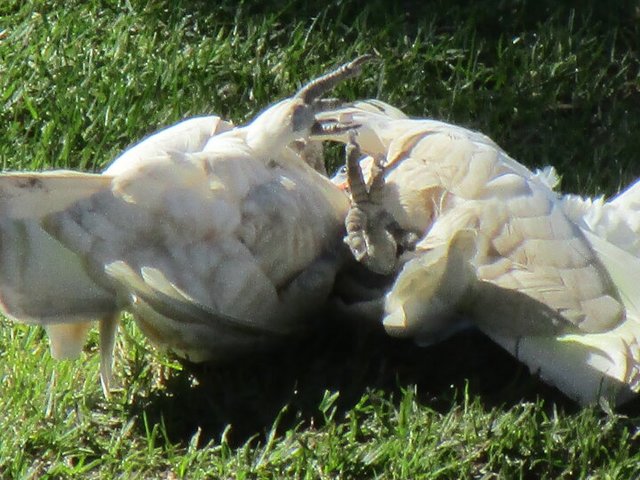Bretrick
Well-known Member
- Location
- Perth Western Australia
Splendid Fairy Wren
There is no false modesty attached to the Splendid Fairy-wren — it lives up to its name.
Male birds in breeding plumage shimmer in electric shades of violet-blue, turquoise and pale-blue, relieved only by a few bands of inky black feathers. However, it is not all glitz and glamour because, as in most species of fairy-wrens, males in non-breeding plumage and females are mostly drab brown, although their long tail feathers are dull-blue.

Two Females and a Male

Azure Kingfisher
Small bright blue and deep orange kingfisher. The smallest of our Kingfishers.
Almost always found above water. It patrols up and down waterways and rivers from perch to perch flying very fast, and only a few meters off the water, typically making a loud high pitched "seeeeeeeep" call.

Red Tailed Black Cockatoo

Red-tailed Black-Cockatoos are easily recognizable.
The male is jet black, with a broad band of bright red in his tail and a dark grey beak.
The female is duller black, with yellow speckles on the head and breast, and yellow patches in her tail. Her beak is whitish in colour.
Two Female Red Tailed Black Cockatoos

Male Red Tailed Black Cockatoo

Family of Red Tailed Black Cockatoos

The Red-tailed Black-Cockatoo is often seen in large flocks, though it also occurs in pairs and trios.
It is an active, noisy and conspicuous species which is mainly arboreal, spending much of the day feeding.
At sunset, flocks of this species are often seen flying high, returning from feeding areas to roosts in large trees along the banks of rivers or streams.
They may be less wary while feeding than at other times, and generally do not allow a close approach by an observer, readily taking flight and screeching loudly.
Bretrick got lucky with the family picture. Driving on the dirt road I spotted them. Parked a little ways away and slowly walked to them and got the shot
Western Quail Thrush
It is found in arid inland habitat in the western regions of Australia.
Western quail-thrushes eat spiders and insects as well as seeds. To find food, they forage on the ground and walk slowly, pecking with their bill on the ground scavenging for seeds. As they forage and eat, Western quail-thrushes hold their larger, previously found items under one foot as they peck their catch to dismember it.

Little Corellas
Small, noisy white cockatoos with an erectile crest. Primarily white with a small pink patch in front of the eye.
Very conspicuous, and often forms large, noisy flocks (up to several thousand birds) around water sources. Roosts in trees and nests in hollows, but primarily feeds on the ground.
Well known for its comical antics; they often appear to play with one another. Typically loud, with a slurred multi-note falsetto call.
Loving pair of Little Corellas

At play "It's Mine"

Give it to me

Wrestling match ensues


Got it

Defeated one takes time out

No hard feelings?

Crowd discusses the match

There is no false modesty attached to the Splendid Fairy-wren — it lives up to its name.
Male birds in breeding plumage shimmer in electric shades of violet-blue, turquoise and pale-blue, relieved only by a few bands of inky black feathers. However, it is not all glitz and glamour because, as in most species of fairy-wrens, males in non-breeding plumage and females are mostly drab brown, although their long tail feathers are dull-blue.

Two Females and a Male

Azure Kingfisher
Small bright blue and deep orange kingfisher. The smallest of our Kingfishers.
Almost always found above water. It patrols up and down waterways and rivers from perch to perch flying very fast, and only a few meters off the water, typically making a loud high pitched "seeeeeeeep" call.

Red Tailed Black Cockatoo

Red-tailed Black-Cockatoos are easily recognizable.
The male is jet black, with a broad band of bright red in his tail and a dark grey beak.
The female is duller black, with yellow speckles on the head and breast, and yellow patches in her tail. Her beak is whitish in colour.
Two Female Red Tailed Black Cockatoos

Male Red Tailed Black Cockatoo

Family of Red Tailed Black Cockatoos

The Red-tailed Black-Cockatoo is often seen in large flocks, though it also occurs in pairs and trios.
It is an active, noisy and conspicuous species which is mainly arboreal, spending much of the day feeding.
At sunset, flocks of this species are often seen flying high, returning from feeding areas to roosts in large trees along the banks of rivers or streams.
They may be less wary while feeding than at other times, and generally do not allow a close approach by an observer, readily taking flight and screeching loudly.
Bretrick got lucky with the family picture. Driving on the dirt road I spotted them. Parked a little ways away and slowly walked to them and got the shot
Western Quail Thrush
It is found in arid inland habitat in the western regions of Australia.
Western quail-thrushes eat spiders and insects as well as seeds. To find food, they forage on the ground and walk slowly, pecking with their bill on the ground scavenging for seeds. As they forage and eat, Western quail-thrushes hold their larger, previously found items under one foot as they peck their catch to dismember it.

Little Corellas
Small, noisy white cockatoos with an erectile crest. Primarily white with a small pink patch in front of the eye.
Very conspicuous, and often forms large, noisy flocks (up to several thousand birds) around water sources. Roosts in trees and nests in hollows, but primarily feeds on the ground.
Well known for its comical antics; they often appear to play with one another. Typically loud, with a slurred multi-note falsetto call.
Loving pair of Little Corellas

At play "It's Mine"

Give it to me

Wrestling match ensues


Got it

Defeated one takes time out

No hard feelings?

Crowd discusses the match




